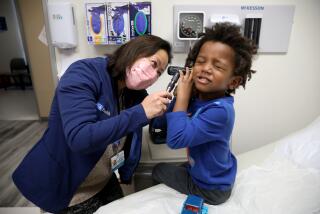Making an appointment for the emergency room a growing trend
- Share via
Lakewood Regional Medical Center last week joined a small but growing number of Southern California hospitals that allow patients to make emergency room appointments online. In exchange for a fee, instead of sitting in a waiting room wondering how long they’ll have to wait, users can show up at the assigned time with the assurance they will be seen within 15 minutes or get their money back.
In a region where it’s routine for emergency room patients at public hospitals to wait half a day or longer to be treated — depending on the complaint — some say the move makes “good business sense.”
“It does not interfere with treating true emergencies on a priority basis; and charging a modest fee discourages tampering,” said Jim Lott, spokesman for the Southern California Hospital Assn., of offering appointments to patients who want to use emergency rooms for “an urgent, but non-emergency condition.”
Fees for the service, called InQuickER, range from $14.99 to $24.99 and are in addition to other costs for the emergency room visit. Officials at the Nashville-based company said that since the system was launched in 2006, 95% of appointments have been kept successfully. Patients must be 18 or older to make an appointment. Those with life-threatening symptoms such as chest pains are told to proceed directly to the emergency room.
The system is in use at 15 hospitals and urgent care centers in seven other states. Locally, eight hospitals — five of which are owned by Dallas-based Tenet Healthcare Corp. — have adopted the service in the last year.
Critics, however, worry that letting people pay to secure appointments may just encourage patients who do not need immediate care to use emergency rooms anyway.
Doctors at hospitals that take appointments say patient satisfaction is higher and that lowering the time spent in an ER reduces the risk of infections spreading in the waiting room.
“InQuickER users are not skipping the line in front of everyone else,” said Chris Song, a company spokesman. “They’re simply waiting somewhere other than the waiting room.”
As of Friday, only one patient had made an appointment at Lakewood Regional, where the average wait at the 14-bed emergency room is about 20 minutes, but sometimes lasts up to two hours.
Hospital officials agreed to pay $3,000 a month for the service. They charge patients $14.99 and expect to recoup that money over time as appointments increase, said spokesman Patrick Houston. One appointment is available each hour, and patients reserve an appointment at least two hours in advance. Houston said the hope is that offering appointments will attract more patients with private insurance.
At John F. Kennedy Memorial Hospital in Indio, which added the system at its 12-bed emergency room in September, about 45 patients have made appointments.
Loma Linda University Medical Center, a regional trauma center, has, since July, charged $24.99 for appointments at its 54-bed emergency room. So far about 400 patients have made appointments, or about three a day, according to Dr. Robert Steele, division chief for adult services in the hospital’s emergency department.
“I’m having medical directors from across the country call me almost on a weekly basis now” to ask how the appointment system is working, Steele said. “ I think this is one of those things that’s going to sweep the country.”
Steele said many patients with primary care doctors and non-urgent ailments still depend on the emergency room.
“Just because somebody comes to the ER and it’s not a life-threatening situation doesn’t mean they don’t need emergency services,” Steele said. “Sometimes we’re the only place that is open.”
One woman wrote him to say her husband would have been unwilling to wait at the emergency room, but that after he made an appointment and was seen, a CT scan showed he had an ailment that could have been fatal.
Tim Barnett, director of emergency services at Lakewood Regional, said an increasing number of people have relied on the emergency room — which must treat all comers — after they lost jobs and health insurance. The appointment system, he said, will make it easier for those still working to seek medical care without taking time off the job. “In this economy, they’re able to come here before their shift, get in and get out,” Barnett said.
Chris Johnson awoke coughing and sniffling one day last week and feared she had the flu. Johnson, 46, of Lakewood, had private health insurance and a new doctor, but decided she needed immediate help.
Although she works as an emergency room technician at Long Beach Memorial Hospital, Johnson went to Lakewood Regional, which is closer to her home. Johnson had not heard about the appointment system, but said she was interested.
“If I had known about it, I would have went online and made a reservation, just to see somebody,” she said.
molly.hennessy-fiske@latimes.com







